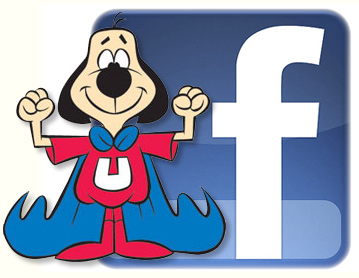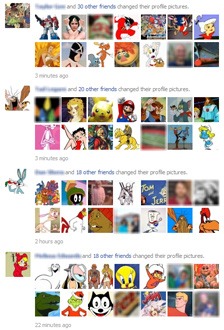Slacktivism: Can Cartoons Raise Awareness or Just Make Us Feel Good?

Did you notice something toony about Facebook last weekend? In an effort to raise awareness for child abuse, thousands of Facebook users changed their profile photos to one of their favorite childhood cartoon characters (full disclosure: mine was Underdog.) Whether it started on accident, was part of a specific campaign, or originated in Greece, this meme seemed to really have legs! Most of my Facebook friends had jumped on the bandwagon by Saturday night, as you can see by the screen shot below collected from my news feed. Stimpy, Smurfette, Foghorn Leghorn, Betty Boop – they’re all there!
While there is a Facebook page setup to promote the campaign, it doesn’t appear to have organized from a particular nonprofit or cause. The campaign spread and went viral via this copied status update, “Change your Facebook profile picture to a cartoon character from your childhood and invite your friends to do the same. Until Monday, Dec 6th of 2010, there should be no human faces on Facebook, but an invasion of memories! This is for a campaign against violence on children.” With that, profile pics were changed and a general sense of awareness for child abuse spread though Facebook – but for what?
Awareness Can Be the Goal, and That’s OK
There are many slacktivism detractors out there, and this campaign had plenty of them poking sticks at it. In the last 24 hours, I have seen countless blog posts, discussions, and news articles all mocking this current meme for doing nothing to actually prevent child abuse. And while I agree that a would be abuser is unlikely to see a Captain Caveman profile pic and decide forgo beating his 8-year-old, I still feel campaigns like this can help the cause because they’re great at awareness.
If awareness is the goal, then surely getting tens of thousands of people to share a message is doing something. If anything, some of these Facebook users may have been looking for an organization or cause to donate to this holiday season, and this campaign may have given them an idea. And maybe this campaign was enough to get an adult who was abused as a child to reach out and help others. The point being that if there is widespread passion around a cause, an awareness campaign like this can go a long way – especially if it goes viral on Facebook!
Slacktivism: To Make Ourselves Feel Good or To Help Others?
Most slacktivism-esque activities involve a great deal of self-gratification – but this is common with most viral activities. If it’s not fun, rewarding, or cool, viral campaigns rarely take off. Allison Fine had some choice words in a Social Actions blog post when she said this about people taking small actions:
“It is quite possible that we will become frantically busy doing a lot of change stuff that does make the doers feel great (which is important ) but doesn’t add up to the systemic social change needed in communities. Does busy mean the same thing as impact?”
She goes on to say that we have to be creative in how we measure success. Maybe we shouldn’t look at funds, but look at followers. Not donations, but impressions. And while it can easily be pointed out that all the awareness in the world can’t actually solve a problem, it is a good start! If you have an urgent need to stop child abuse in its tracks, a viral Facebook campaign probably isn’t the best tactic to focus on. But if you’re simply trying to raise awareness for a broad issue during the holiday season, a slacktivism-based social media campaign might be a good fit.
What did you think about this campaign? Can small gestures like this make a difference, or are they keeping us from focusing on actions that can have a bigger impact?



